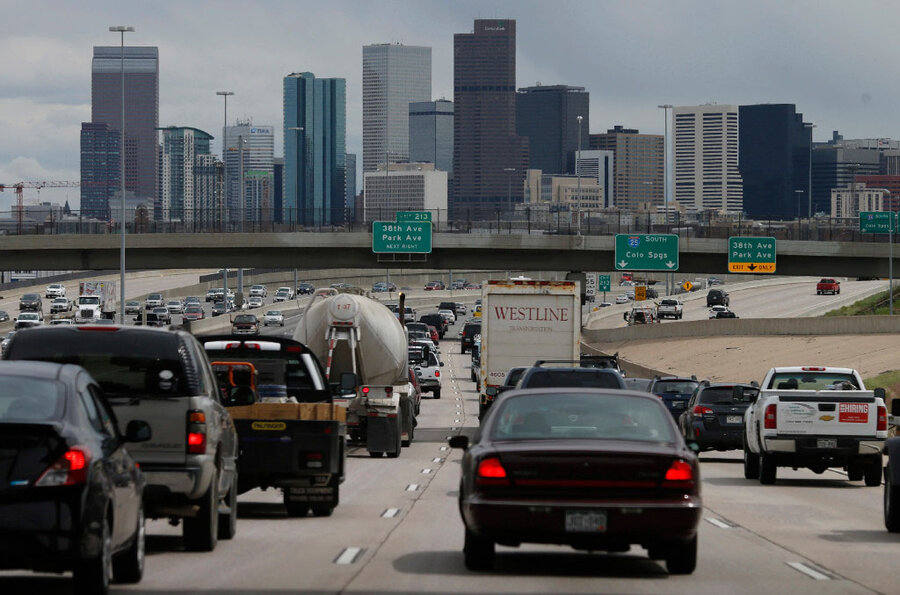Civil engineers give America's infrastructure a D+. Is that credible?
Loading...
The American Society of Civil Engineers has just confirmed what residents of Flint, Mich., and Oroville, Calif., already know too well: America’s infrastructure is in bad shape. On Thursday, the ASCE released its 2017 Infrastructure Report Card, giving a D+ to the physical systems that keep America running.
This grade might not surprise the Americans affected by toxic water and failing dams, or who face more mundane problems like Boston's aging subway lines. Indeed, the Society has given US infrastructure a D or D+ in each of the six report cards it has issued since 1998. The biggest change is the estimated repair cost, increasing from $1.3 trillion in 2001 to $4.59 trillion today.
But is this report credible? “The ASCE’s infrastructure report is like asking your barber whether you need a haircut,” wrote Forbes’s Tim Worstall on Thursday. The Washington Post’s Charles Lane phrased the same argument more dryly back in 2011, when he wrote that the ASCE “has a vested interest in greater infrastructure spending, which means more work for engineers.”
With the Trump administration vowing to spend $1 trillion to rebuild America's infrastructure, US civil engineers could have plenty of work in the years ahead. But those familiar with America’s energy, water, and transportation needs say that the ASCE’s report is a necessary – and reliable – starting point for fixing our infrastructure.
“The challenge of trying to identify our nation's infrastructure weaknesses is huge,” says transportation expert Robert Puentes, president and chief executive officer of the nonprofit Eno Center for Transportation in Washington, D.C. In a phone interview, he describes the ASCE’s report as “the best that they can do.”
“They're basically relying on detailed analysis that's been done by federal agencies for the most part, so those [numbers] are fine,” he continues. While the engineers did cite privately-generated reports in some categories – for instance, the US Travel Association for Aviation – federal agencies such as the Department of Transportation and the EPA generated the bulk of their data.
Among the 28 engineers who sorted through these numbers, several worked for private engineering firms that could benefit from greater infrastructure investment. But one of their colleagues, Janey Camp, didn't see a reason to question their motives, or the report's credibility.
“Our first duty as civil engineers is to protect the safety of the public,” she tells The Christian Science Monitor. Dr. Camp, a research associate professor at Vanderbilt University’s Department of Civil and Environmental Engineering, sat on the volunteer committees that prepared the 2013 and 2017 Report Cards.
She doesn't describe it as a rubber-stamp group. "We have a large group discussion, as the broader committee, of 'Why don't we raise or lower or keep the grade the same? And there's a lot of Q&A associated with that," she says.
“It's not about paying ourselves,” Camp tells The Monitor. “We’re here for the betterment of the people.”
Whether they work for private companies, government agencies, or universities, Camp and her colleagues all subscribe to a Code of Ethics for Engineers. And the committee’s conclusions on one category in the latest report, railroad transportation, bolster her point about putting the public interest first.
Industries with a dominant private-sector role, like freight rail, can be tough to evaluate, explains Mr. Puentes of the Eno Center. "There's no national assessment that's being done, because it's not a government responsibility."
To assess the nation’s freight and passenger rails, the committee indeed had to look beyond the public sector, citing the American Association of Railroads heavily in its report. But rather than slap it with a low grade to encourage both railroad companies and the federal government to invest, the committee gave it a B, the highest grade of any category.
Puentes considers the report a fair assessment, and is already considering next steps. “The civil engineers' report does a good job of raising the issue, of sounding the alarm, for the crumbling infrastructure needs that we have, but we have to get specific.”
In particular, he wants Americans to recognize that the eye-popping sums the report calls for don’t all have to come from one place. “There's an assumption that a lot of it's gonna be federal,” he says. The ASCE’s president, Norma Jean Mattei, has proposed raising the federal gas tax by 25 cents, indexed to inflation, to help pay for it.
But Puentes predicts that infrastructure funding will come from a mix of federal, state, and local sources, rather than one massive infrastructure bill. Last year, voters across the country approved billions of dollars in infrastructure ballot measures. “They're not simply going to wait for one single grand solution to come from the top down,” says Joseph Kane, a senior research analyst at the Brookings Institution.
Wherever the funding comes from, Camp says she's eager to see results. “My parents' generation helped give us the interstates," she reflects. "What am I giving my kids? A big problem, as far as infrastructure is concerned.”
“Somebody has to step up and say ‘Yes, we have to do this, we have to move forward.’”








